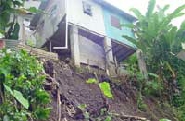A community on the Caribbean island of St Lucia is to receive practical, hands-on help from experts at Bristol University on how best to tackle the landslides that affect an area of shanty housing.
Professor Malcolm Anderson and PhD researcher Liz Holcombe from the University’s School of Geographical Sciences will be heading out to St Lucia this week. There, they will transform one of the shanty houses into a ‘show home’ that demonstrates the simple, low cost measures local people can adopt to prevent their homes being damaged or destroyed by landslides.
Such landslides are a major hazard in tropical areas like St Lucia but relatively simple measures such as improving drainage design, lining open storm-water drains and monitoring the water table in slopes can easily be adopted by local people to ease the problem.
The visit by Professor Anderson and his team is part of MoSSaiC (Management of Slope Stability in Communities), a project set up by Bristol University and currently being piloted in St Lucia in partnership with the Government.
MoSSaiC was developed as a result of the success of a software package for assessing landslide risk, created by Professor Anderson and his colleagues some years ago. Called CHASM (Combined Hydrology and Stability Model), the software has been used on a number of major engineering projects in developing countries across the world and has been featured on BBC Radio 4 Science Now. However, the software’s inventors were keen to provide these countries with more than just external technical input – and so MoSSaiC was born.
The project aims to provide not only computer software but a whole range of advice and training to ensure ‘capacity build’ takes place at the community level on landslide prediction and monitoring – thus making the Government less reliant on outside help in tackling the problem.
In St Lucia, the Minister of Agriculture has already provided the University with a team of government staff to help implement the project and the Ministry of Public Works has recently established a local field team to undertake slope stability assessments on road cut sites. The slope inventory they provide has been fed into CHASM software to analyse landslide risk and importantly to prioritise expenditure and maintenance programmes.
Professor Anderson said: “We are greatly looking forward to taking our work into shanty housing areas in St Lucia and working with the communities there. Community ‘capacity build’ is the key element in the MoSSaiC project and so we will, in partnership, be enhancing community skills with which to tackle landslide hazard – skills that can be readily passed on to others. This kind of knowledge transfer is wonderful as the costs are small but the practical and social benefits can be enormous.”
CHASM (Combined Hydrology and Stability Model)
CHASM is a computer program designed to help countries with high rainfall predict and control devastating landslides. Countries with heavy tropical rain often find that important and expensive development projects can be ruined by landslides caused by this rain.
The CHASM program, when fed the relevant data, can calculate the changes in the water table of a slope and suggest the angle of slope least likely to result in a landslide. The program is the result of 18 years of research at Bristol University on the flow of water over and through soil and the development of mathematical modelling of water flow.
The software is now well established within the wider engineering community. The Windows version is sold by the University through Bristol Innovations Ltd.
